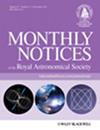关于 AGN 在形成星团红色序列中的作用的新见解
IF 4.7
3区 物理与天体物理
Q1 ASTRONOMY & ASTROPHYSICS
引用次数: 0
摘要
由于各种望远镜设施投入了大量时间来研究 z = 2.2 的蜘蛛网原星团,迄今为止,它仍然是研究最为广泛的原星团之一。我们在此报告该领域的最新研究成果,为以往有关高红移下星团形成的研究增添了新的内容。以往的研究报告显示,在 3700 个移动 Mpc3 中,大质量 Hα (+ [N ii])发射星系的密度明显过大(δ∼ 10)。根据它们的静帧光学和红外特征,其中许多以前被认为是尘埃较多、恒星形成活跃的星系。然而,这项研究认为,考虑到多波长光谱能量分布(SED)拟合包括了AGN成分,其中三分之一的星系更有可能是具有低亮度活动星系核(AGN)的 "被动演化 "星系,而不是恒星形成星系。要使它们基于 SED 的恒星形成率有效,它们的大部分 Hα + [N ii] 辐射应该来自中心 AGN。最近的钱德拉/X射线深度观测尤其支持了这项工作与以往研究(包括我们的研究)在解释上的差异。此外,我们还从光谱学角度证实了其中一个 AGN 的静态性质,它不仅有多条恒星吸收线,而且还有低电离发射线。这一重要更新为我们提供了关于 AGN 在形成当今宇宙中观测到的星团红色序列中的作用的新见解。本文章由计算机程序翻译,如有差异,请以英文原文为准。
New insights into the role of AGNs in forming the cluster red sequence
As a considerable investment of time from various telescope facilities were dedicated toward studying the Spiderweb protocluster at z = 2.2, it so far remains one of the most extensively studied protocluster. We report here the latest results in this field, adding a new dimension to previous research on cluster formation at high redshift. Previous studies have reported a significant overdensity (δ ∼ 10) of massive Hα (+ [N ii]) -emitting galaxies in 3700 comoving Mpc3. Many of these were previously considered to be dusty, actively star-forming galaxies, given their rest-frame optical and infrared features. However, this study argues that a third of them are more likely to be “passively-evolving” galaxies with low-luminosity active galactic nuclei (AGNs) rather than star-forming galaxies, given the multi-wavelength spectral energy distribution (SED) fitting including an AGN component. For their SED-based star formation rates to be valid, bulk of their Hα + [N ii] emission should come from the central AGNs. This difference in interpretation between this work and past studies, including ours, is particularly supported by the recent deep Chandra/X-ray observation. Furthermore, we have spectroscopically confirmed a quiescent nature for one of these AGNs, with its multiple stellar absorption lines but also low ionisation emission lines. This important update provides new insights into the role of AGNs in forming the cluster red sequence observed in the present-day universe.
求助全文
通过发布文献求助,成功后即可免费获取论文全文。
去求助
来源期刊

Monthly Notices of the Royal Astronomical Society
ASTRONOMY & ASTROPHYSICS-
CiteScore
9.10
自引率
37.50%
发文量
3198
审稿时长
3 months
期刊介绍:
Monthly Notices of the Royal Astronomical Society is one of the world''s leading primary research journals in astronomy and astrophysics, as well as one of the longest established. It publishes the results of original research in positional and dynamical astronomy, astrophysics, radio astronomy, cosmology, space research and the design of astronomical instruments.
 求助内容:
求助内容: 应助结果提醒方式:
应助结果提醒方式:


